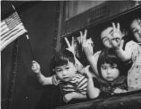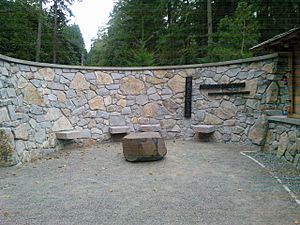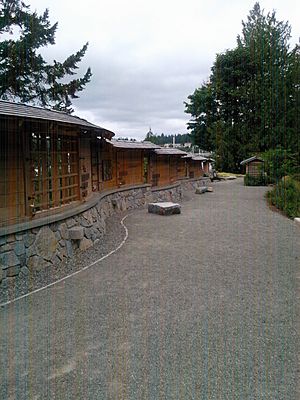Bainbridge Island Japanese American Exclusion Memorial facts for kids

The Bainbridge Island Japanese American Exclusion Memorial is an outdoor exhibit. It helps us remember when Japanese Americans from Bainbridge Island were forced to leave their homes. This happened during World War II. The memorial is in Washington, on the south shore of Eagle Harbor. It is across from the town of Winslow. This memorial is part of the Minidoka National Historic Site in Idaho. Its main message is "Nidoto Nai Yoni," which means "Let It Not Happen Again."
Contents
Why Was It Built?
Japanese immigrants first came to Bainbridge Island in the 1880s. They worked in sawmills and picked strawberries. By the 1940s, they were an important part of the island's community.
The First People to Leave
Because Bainbridge Island was close to naval bases, its Japanese American residents were the first in the entire country to be interned. "Internment" means they were forced to move to special camps. These camps were often far from their homes.
On March 30, 1942, 227 Japanese Americans from the island were told to leave. They had only six days' notice. They left by ferry. At that time, 276 Japanese American people lived on the island. Those who were away for school or military service could not return home. Most of these families were sent to Manzanar, California. Some were later moved to Minidoka, Idaho.
Local newspapers, like The Bainbridge Review, spoke out against this forced removal. They even published letters from the people in the camps. A famous photo shows Fumiko Hayashida from Bainbridge Island. She was with her 13-month-old daughter, getting ready to board the ferry. This picture became a symbol of the internment. After World War II ended, 150 people returned to the island. By 2011, about 90 survivors were still alive, and 20 of them still lived on the island.
What You'll See at the Memorial
A group called the Bainbridge Japanese American Community helped create this memorial. They planned to build a large facility with a pier and a visitor center. In May 2008, Congress decided to include the memorial as part of the Minidoka National Historic Site. This was part of the Consolidated Natural Resources Act of 2008. By March 2009, the organizers had raised a lot of money for the project.
The Story Wall
The first part of the memorial built was an outdoor cedar "story wall." This wall has the names of all 276 Japanese Americans who lived on the island at that time. The groundbreaking ceremony for the wall was on March 30, 2009. This was exactly 67 years after the forced removal. Fumiko Hayashida, who was 98 and the oldest survivor, spoke at the ceremony.
Nature and Art
The wall was designed by Johnpaul Jones, a local architect. He is an American Indian. He also worked on the surrounding landscape. He wanted it to look natural. He planted native plants like sword fern, mahonia, salal, and shore pine.
Local artist Steve Gardner created special art pieces called friezes for the wall. These friezes show scenes of residents being led onto the ferries. He said the project really touched him. He felt it was a story about American citizens. The memorial officially opened to the public on July 30, 2011.




